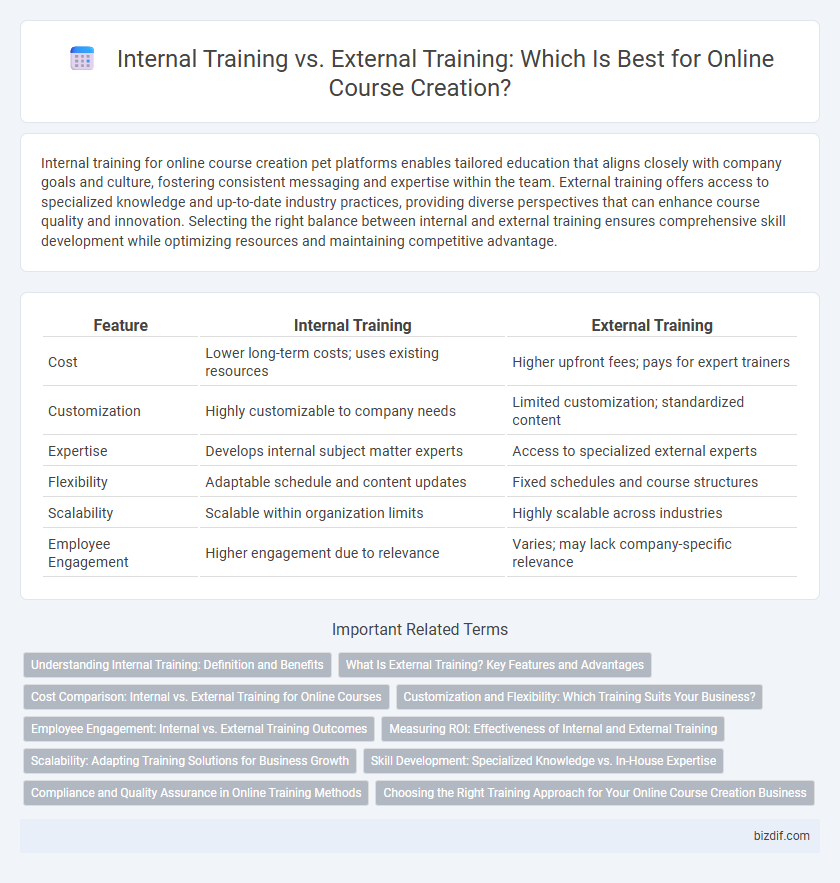Internal training for online course creation pet platforms enables tailored education that aligns closely with company goals and culture, fostering consistent messaging and expertise within the team. External training offers access to specialized knowledge and up-to-date industry practices, providing diverse perspectives that can enhance course quality and innovation. Selecting the right balance between internal and external training ensures comprehensive skill development while optimizing resources and maintaining competitive advantage.
Table of Comparison
| Feature | Internal Training | External Training |
|---|---|---|
| Cost | Lower long-term costs; uses existing resources | Higher upfront fees; pays for expert trainers |
| Customization | Highly customizable to company needs | Limited customization; standardized content |
| Expertise | Develops internal subject matter experts | Access to specialized external experts |
| Flexibility | Adaptable schedule and content updates | Fixed schedules and course structures |
| Scalability | Scalable within organization limits | Highly scalable across industries |
| Employee Engagement | Higher engagement due to relevance | Varies; may lack company-specific relevance |
Understanding Internal Training: Definition and Benefits
Internal training in online course creation involves developing customized educational programs within an organization to enhance employee skills and knowledge. It offers benefits such as alignment with company culture, cost-effectiveness compared to external providers, and the ability to address specific organizational needs through tailored content. Leveraging internal subject matter experts accelerates learning relevance and fosters greater employee engagement and retention.
What Is External Training? Key Features and Advantages
External training involves engaging third-party providers or specialized organizations to deliver educational content, offering access to expert knowledge and updated industry practices. Key features include customizable courses, diverse formats such as webinars and workshops, and the ability to scale learning across different departments or locations. Advantages consist of cost-effectiveness by reducing internal resource allocation, exposure to fresh perspectives, and accelerated skill development aligned with current market trends.
Cost Comparison: Internal vs. External Training for Online Courses
Internal training for online courses typically incurs lower costs by utilizing existing staff and resources, reducing expenses related to external trainer fees and travel. External training often involves higher upfront investments due to specialist expertise, customized content development, and licensing fees. Cost efficiency in internal training improves with scale, while external training may offer specialized knowledge that justifies its premium in certain scenarios.
Customization and Flexibility: Which Training Suits Your Business?
Internal training offers unparalleled customization tailored specifically to a company's unique processes, culture, and goals, ensuring content aligns perfectly with business objectives. External training provides flexibility with access to a broad range of expert-led courses and up-to-date industry knowledge, benefiting organizations seeking diverse perspectives and scalable solutions. Selecting between internal and external training depends on prioritizing personalized relevance versus adaptable, comprehensive learning experiences for employee development.
Employee Engagement: Internal vs. External Training Outcomes
Internal training programs foster higher employee engagement by delivering tailored content aligned with company culture and goals, resulting in increased motivation and productivity. External training often provides broader industry knowledge but may lack personalization, leading to varied engagement levels among employees. Companies investing in internal training report greater retention rates and stronger team cohesion compared to those relying solely on external courses.
Measuring ROI: Effectiveness of Internal and External Training
Measuring ROI in online course creation reveals that internal training often delivers higher cost efficiency due to tailored content and alignment with company goals, resulting in increased employee productivity and retention rates. External training, while potentially more expensive, provides access to expert knowledge and industry best practices, leading to faster skill acquisition and innovation impact. Data-driven analytics from LMS platforms quantify training effectiveness by tracking completion rates, learner engagement, and performance improvements, enabling organizations to compare ROI between internal and external programs effectively.
Scalability: Adapting Training Solutions for Business Growth
Internal training enables seamless scalability by leveraging existing organizational knowledge and infrastructure, ensuring consistent content delivery tailored to company-specific needs. External training offers flexibility to rapidly incorporate diverse expertise and cutting-edge methodologies, supporting scalable learning across various departments and locations. Both approaches can be strategically combined to optimize scalability and align training solutions with evolving business growth demands.
Skill Development: Specialized Knowledge vs. In-House Expertise
Internal training focuses on developing in-house expertise by leveraging company-specific knowledge and tailored skill-building programs that align closely with organizational goals. External training offers specialized knowledge from industry experts, providing access to the latest trends, technologies, and best practices beyond the company's immediate resources. Balancing both approaches enhances overall skill development, combining proprietary insights with cutting-edge external expertise.
Compliance and Quality Assurance in Online Training Methods
Internal training improves compliance by tailoring content to specific company policies and standards, ensuring consistent quality across all online courses. External training offers access to industry experts and standardized best practices, enhancing quality assurance through proven methodologies. Combining both approaches optimizes compliance and elevates the overall effectiveness of online training programs.
Choosing the Right Training Approach for Your Online Course Creation Business
Internal training leverages in-house expertise and customized content tailored to specific company goals, enhancing employee skills directly relevant to your online course creation business. External training provides access to specialized knowledge, industry best practices, and fresh perspectives that may not be available internally, supporting rapid skill development and innovation. Evaluating factors like budget, content specificity, and team capabilities ensures the selection of the most effective training approach for scalable and high-quality online course production.
Internal training vs External training Infographic

 bizdif.com
bizdif.com